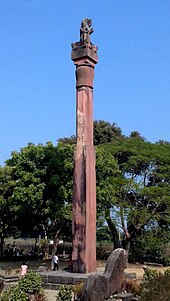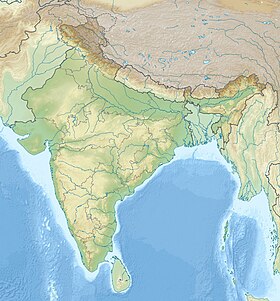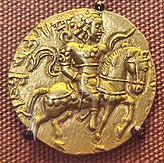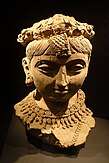Budhagupta
| Budhagupta | |
|---|---|
 Gold coin of Budhagupta | |
| Gupta emperor | |
| Reign | c. 476 – c. 495 CE |
| Predecessor | Kumaragupta II |
| Successor | Narasimhagupta |
| Dynasty | Gupta |
| Religion | Hinduism[1] |
Budhagupta (Gupta script: ![]()
![]()
![]()
![]() Bu-dha-gu-pta,[4] r. c. 476 – 495 CE) was a Gupta emperor and the successor of Kumaragupta II. He was the son of Purugupta and was succeeded by Narasimhagupta.[5]
Bu-dha-gu-pta,[4] r. c. 476 – 495 CE) was a Gupta emperor and the successor of Kumaragupta II. He was the son of Purugupta and was succeeded by Narasimhagupta.[5]
Rule
[edit]Budhagupta had close ties with the rulers of Kannauj and together they sought to run the Alchon Huns (Hunas) out of the fertile plains of Northern India.
Northern India, and in particular the area of Eran, was next invaded by the Alchon Huns ruler Toramana, who set up his own inscription there, the Eran boar inscription of Toramana, circa 510-513 CE.
Inscriptions
[edit]
| Gupta Empire 320 CE–550 CE | ||||||||||||||||||||||||||||||||||||
|---|---|---|---|---|---|---|---|---|---|---|---|---|---|---|---|---|---|---|---|---|---|---|---|---|---|---|---|---|---|---|---|---|---|---|---|---|
|
||||||||||||||||||||||||||||||||||||
The Damodarpur copper-plate inscription informs us that Pundravardhana bhukti (the present-day North Bengal) was ruled by his two viceroys (Uparika Mahararaja) Brahmadatta and Jayadatta.
The Eran stone pillar inscription of two brothers, Mātṛviṣṇu and Dhanyaviṣṇu mentions Budhagupta as their emperor (Bhupati), under whom Maharaja Surashmichandra was governing the land between the Yamuna and the Narmada[5] The Budhagupta inscription on the Eran column is on the west face towards the bottom of the lower and square part of a large monolithic red-sandstone column situated near the ruined group of temples at Eran. The inscription refers to the reign of Budhagupta over the area "between the rivers Kâlindi and Narmadâ", and it is dated 484–485 CE. The object of it is to record the erection of the column, which is called 'dhvajastambha' or flag staff of the god Vishnu. This pillar is about 48 feet high. This inscription was discovered by T.S. Burt in 1838.[8]
A pedestal of a Buddha statue found at Govindnagar near Mathura bears an inscription "in the reign of Budhagupta in year 161" (circa 480 CE). This is the only known epigraphic evidence showing that Budhagupta's authority extended to Mathura in the north.:[9][10]
...Today, when king Budhagupta of the famous dynasty is administering the whole earth, in the year one hundred and sixty one...
— Budhagupta inscription of Govindnagar, Mathura.[11]
Two standing Buddha images from Sarnath are known, with bear dated inscriptions mentioning the "Gift of Abhayamitra in 157 in reign of Buddhagupta" (157 of the Gupta era being 477 CE).[11][12][13][14] There are also stone inscriptions in Varanasi and Eran and a seal from Nalanda mentioning Budhagupta as the ruler, as well as several copperplate inscriptions.[11]
First Buddha statue with inscription of Budhagupta
[edit]-
Buddha inscription of Budhagupta in the Gupta Era year 157, with extrapolation and English translation.[16]
Second Buddha statue with inscription of Budhagupta
[edit]A second statue of the standing Buddha found in Sarnath has a dated inscription (year 157) in the name of Budhagupta. This statue is defaced, but the devotees at the feet of the Buddha are beautifully preserved. The content is partially preserved, but essentially identical to an inscription on the first statue, made by the same donor, allowing for reconstruction.[17]
-
Buddhist devotee on the second statue of the standing Buddha (fragment), inscribed "Gift of Abhayamitra in 157 in the reign of Buddhagupta" (477 CE). Sarnath Museum.[12][13]
-
Buddha inscription of Budhagupta in the Gupta Era year 157 (second statue), with extrapolationa and English translation.[17]
Other inscriptions of Budhagupta
[edit]-
Budhagupta pillar inscription at Eran.
-
Copper-plate charter of Budhagupta, dated Gupta year 168
References
[edit]- ^ A History of Ancient and Early Medieval India by Upinder Singh p.521
- ^ Journal Of The Epigraphical Society Of India Vol Ix. 1982. p. 7.
- ^ For Sankarpur and Mathura: Salomon, Richard. Indian Epigraphy A Guide To The( Book Za.org). p. 145.
- ^ Allen, John (1914). Catalogue of the coins of the Gupta dynasties. p. 153.
- ^ a b Raychaudhuri, H.C. (1972). Political History of Ancient India, Calcutta: University of Calcutta, p. 522
- ^ Fleet, John Faithfull (1888). Corpus Inscriptionum Indicarum Vol. 3. p. 88.
- ^ Bajpai, K. D. (2004). Indian Numismatic Studies. Abhinav Publications. pp. 19–20. ISBN 978-81-7017-035-8.
- ^ Dr. Mohan Lal Chadhar, Eran Ki Tamrapashan Sanskriti, Sagar, MP 2009, pp 11,ISBN 81-89740-07-5
- ^ Agarwal, Ashvini (1989). Rise and Fall of the Imperial Guptas, Delhi:Motilal Banarsidas, ISBN 81-208-0592-5, pp. 226–30
- ^ a b Sharma, R.C. (1994). The Splendour of Mathura Art and Museum. D. K. Printworld Pvt. Ltd. p. 143.
- ^ a b c Journal Of The Epigraphical Society Of India Vol IX. 1982. pp. 6-12.
- ^ a b "Collections-Virtual Museum of Images and Sounds". vmis.in. American Institute of Indian Studies.
- ^ a b "Collections-Virtual Museum of Images and Sounds". vmis.in. American Institute of Indian Studies.
- ^ a b "Collections-Virtual Museum of Images and Sounds". vmis.in. American Institute of Indian Studies.
- ^ Majumdar, B. (1937). Guide to Sarnath. p. 89.
- ^ a b Sahni, Daya Ram (1920). Annual Report Of The Archaeological Survey Of India 1914-15. p. 125 inscription XVII.
- ^ a b Sahni, Daya Ram (1920). Annual Report Of The Archaeological Survey Of India 1914-15. p. 124 inscription XVI.
- ^ Description and translation of the inscription in: Thaplya, Kiran Kumar (1982). Journal Of The Epigraphical Society Of India Vol Ix. pp. 6-11.





![Buddha statue inscribed "Gift of Abhayamitra in 157 in the reign of Buddhagupta" (476 CE) Sarnath Museum.[14][15][16]](http://up.wiki.x.io/wikipedia/commons/thumb/0/07/Buddha_statue_inscribed_reign_of_Budhagupta_year_157_%28476_CE%29_Sarnath_Museum.jpg/56px-Buddha_statue_inscribed_reign_of_Budhagupta_year_157_%28476_CE%29_Sarnath_Museum.jpg)
![Buddha inscription of Budhagupta in the Gupta Era year 157, with extrapolation and English translation.[16]](http://up.wiki.x.io/wikipedia/commons/thumb/c/c7/Buddha_inscription_of_Budhagupta_in_the_Gupta_Era_year_157.jpg/120px-Buddha_inscription_of_Budhagupta_in_the_Gupta_Era_year_157.jpg)
![Buddhist devotee on the second statue of the standing Buddha (fragment), inscribed "Gift of Abhayamitra in 157 in the reign of Buddhagupta" (477 CE). Sarnath Museum.[12][13]](http://up.wiki.x.io/wikipedia/commons/thumb/4/4f/Buddhist_devotee_on_a_statue_of_Buddha_standing_inscribed_Gift_of_Abhayamitra_in_157_GE_%28477_CE%29_in_reign_of_Buddhagupta.jpg/56px-Buddhist_devotee_on_a_statue_of_Buddha_standing_inscribed_Gift_of_Abhayamitra_in_157_GE_%28477_CE%29_in_reign_of_Buddhagupta.jpg)
![Buddha inscription of Budhagupta in the Gupta Era year 157 (second statue), with extrapolationa and English translation.[17]](http://up.wiki.x.io/wikipedia/commons/thumb/f/fe/Buddha_inscription_of_Budhagupta_in_the_Gupta_Era_year_157_%28second_statue%29.jpg/120px-Buddha_inscription_of_Budhagupta_in_the_Gupta_Era_year_157_%28second_statue%29.jpg)
![Inscribed pedestal of Buddha installed "in the reign of Budhagupta in year 161" (circa 480 CE). Govind Nagar. Mathura.[10][18]](http://up.wiki.x.io/wikipedia/commons/thumb/7/7f/Inscribed_Pedestal_of_Buddha_Image_Installed_in_the_Reign_of_Budha_Gupta_-_Circa_480_CE_-_Govind_Nagar_-_ACCN_82-240_-_Government_Museum_-_Mathura_2013-02-23_5537.JPG/120px-thumbnail.jpg)

